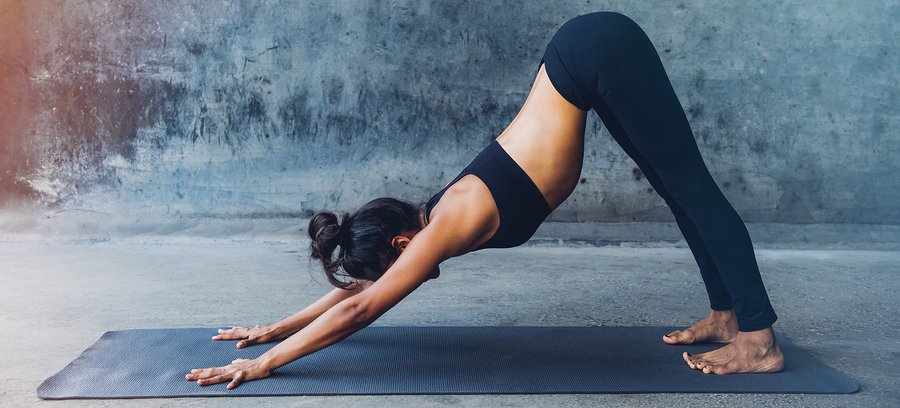There are certain conditions that many of us are just not comfortable discussing with other people, and one of those is urinary incontinence. No one wants to admit to having urine leakage when they laugh too much, problems holding it in until reaching a restroom, or needing to wear an absorbent adult undergarment. But if this has been your situation, take heart that you may not have to resign yourself to more and more time spent alone to avoid embarrassment. That’s because new research has discovered that the answer to your problems might lie in yoga.
The study, which took place at the University of California, San Francisco, found that practicing yoga may help reduce urinary incontinence in older women.1 “Women’s Health and Urinary Functions.” American Urological Association. 20 May 2018. Accessed 27 May 2018. http://auanet.mediaroom.com/2018-05-20-Womens-Health-and-Urinary-Functions. This is based on an investigation involving 56 women ranging in age from 55 through 83. All of the subjects had been experiencing frequent urinary incontinence and none of them were regular yoga practitioners.
The participants were randomly divided into two different physical activity groups, both of which met twice a week for sessions and were given instructions for exercises to do once a week at home. For a three-month period, one group focused on a core set of 8 widely used yoga postures that are potentially generalizable to yoga instruction across the country and can be adapted for women of all ages, including those with decreased flexibility or mobility. The set included: Tadasana (mountain pose), Utkatasana (chair pose), Trikonasana (triangle pose), Malasana (squat pose), Viparita Karani Variation (legs up the wall pose), Salamba Set Bandhasana (supported bridge pose), Supta Baddha Konasana (reclined cobbler’s pose), and Savasana (sponge or resting pose). While teaching these postures, instructors emphasized specific ways of practicing each posture in order to foster awareness of pelvic floor structures and increase control over the pelvic floor muscles, in addition to improving general fitness and conditioning and promoting mindfulness, deep breathing, and relaxation.
The second group was also working out, but they were taught stretching and strengthening exercises with no focus on the pelvic floor.
All the women were asked to maintain daily diaries of their voiding. By the end of the trial, both groups showed vast improvement, but those doing yoga had incredible results. The volunteers in the strengthening and stretching group had a 51 percent decrease in urinary incontinence. And those in the yoga group fared even better, with a whopping 74 percent reduction in frequency of urinary incontinence.
While the study was very small and would need to be replicated with a much larger pool of subjects to be certain that the outcomes are valid, these impressive changes are definitely worth noting. It is also positive that yoga—and the other exercises, for that matter—seem to be beneficial for women ranging fairly far in age. After all, a woman in her late 50s is likely to be stronger and fitter than a woman in her early 80s, yet they all achieved similar results.
This is particularly important since urinary incontinence was shown in a 2016 study at the Geisel School of Medicine at Dartmouth in Hanover, New Hampshire to affect more than 37 percent of women between the ages of 51 and 74.2 Erekson, Elisabeth A.; et al. “10-year Prevalence and Incidence of Urinary Incontinence Among Older Women: A Longitudinal Analysis of the Health and Retirement Study.” Journal of the American Geriatrics Society. 20 June 2016. Accessed 28 May 2018. http://www.ncbi.nlm.nih.gov/pmc/articles/PMC4916851/. And both the strengthening exercises and yoga tested in the current research appear to be considerably more effective than standard treatments for incontinence. A urologist will often begin with helping you manage your fluid intake and train your bladder to effectively delay urination, then progress to prescribing pharmaceutical medications and suggesting surgical procedures.
Yoga, on the other hand, is a wonderful workout for people of all ages because certain poses can strengthen the muscles associated with urinary incontinence and bladder control. On top of that, it helps restore flexibility that may have been lost as we age, and it also has been shown to improve balance, which is important as older people often have an onset of health issues after experiencing a bad fall. And the deep breathing techniques learned through yoga provide stress reduction, which can benefit everyone, but especially those suffering from anxiety or depression over their incontinence issues.
If you’ve never practiced yoga before, it is essential to learn from an experienced instructor who will teach you how to perform the poses correctly. You can always enjoy the group environment of a class, but once you’re comfortable with numerous poses, you can then practice yoga at home at your convenience as well.
References
| ↑1 | “Women’s Health and Urinary Functions.” American Urological Association. 20 May 2018. Accessed 27 May 2018. http://auanet.mediaroom.com/2018-05-20-Womens-Health-and-Urinary-Functions. |
|---|---|
| ↑2 | Erekson, Elisabeth A.; et al. “10-year Prevalence and Incidence of Urinary Incontinence Among Older Women: A Longitudinal Analysis of the Health and Retirement Study.” Journal of the American Geriatrics Society. 20 June 2016. Accessed 28 May 2018. http://www.ncbi.nlm.nih.gov/pmc/articles/PMC4916851/. |












Yoga is a RELIGIOUS practice,
Yoga is a RELIGIOUS practice, from Hinduism. It can open a person to influence of evil spirits. One should NEVER write an article advocating the use of yoga without warning people of this, and that it is NOT COMPATIBLE with the Christian faith, and may also be incompatible with other religions as well. We have a right to know. The mixture of religious practices without warnings is causing many to turn away from natural healing, and we need those people to be active with natural healing methods, to provide pressure to keep them legal! Please do not EVER advocate yoga without a warning! If you are not willing to do this, then I won’t trust your advice.
You are certainly correct…I
You are certainly correct…I’ve told people for over 40 years…there is a better way than yoga…
thnks; might try yoga I
thnks; might try yoga I already use soy; bok choy and green tea;
Hello,
Hello,
I am wondering about the specific instructions about the pelvic floor in these exercises. How can we get these additional instructions if many yoga teachers would not know about these? Would there possibly be a video teaching the complete yoga instructions for the pelvic floor? Thank you.
Oh please, the article is
Oh please, the article is about yoga helping incontinence in women 55 – 83. Yet the picture is of a sexy, flexible, lithe teenager! Come on — get real! Show a pic of a class of senior women practicing yoga, for god’s sake. Just like every other merchant, using sex to sell.
Hi Barbara,
Hi Barbara,
That was my fault, I’m the webmaster. We use stock photography and believe it or not, all the stock photos were of young people. We don’t sell anything in yoga; in fact, we don’t sell anything on this website. So, we are not trying to use sex to sell. Most of our readers are women too. I just thought it was an interesting photo! Sorry you didn’t like it.
Sandy